
|   |

|   |
 e-mail: leelakaverivenkat@gmail.com Dhauli-Kalinga Mahotsav: When war games transform into peace messages Photos courtesy: Orissa Dance Academy March 11, 2023 It is a question of intent - which can transform what spells belligerent war action, into one of utter peace, creating aesthetic joy in both participant and audience. The same adroit skill of a parry and thrust movement with sword and shield in war exercises, meant to destroy the enemy, transforms into the grace and allure of Martial Arts, where the purpose changes to one of creating an artistic experience. And what better venue for this can there be than the foothills of ancient Dhauli in Odisha, where the carnage in the Kalinga War, turned Chanda Ashoka, an indefatigable conqueror of lands, into Dharma Ashoka - the conqueror of hearts and minds, through the message of peace and Buddhism. 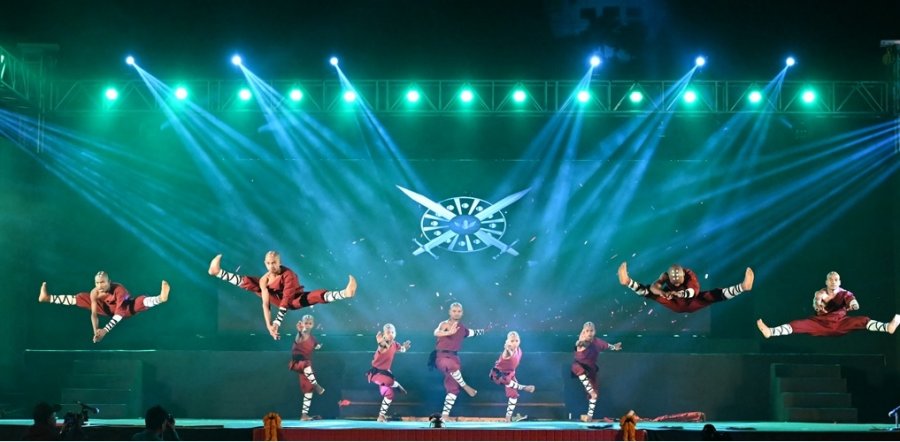 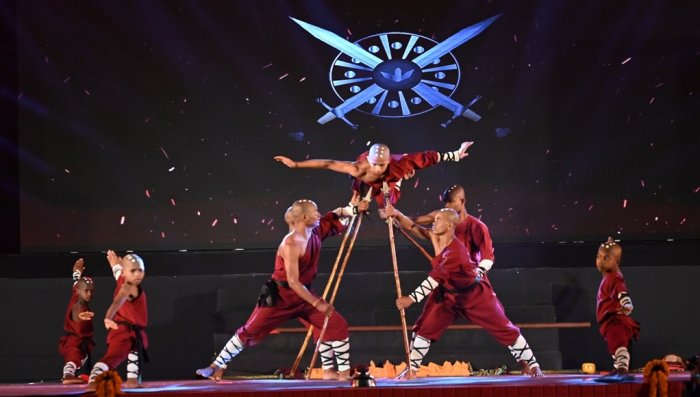 Binash Kumar Mishra and group of AOMAA Gurukul in traditional martial arts What was initiated in 2003 atop the Dhauli hill at the site of the Peace Pagoda as a Martial Arts Festival by Art Vision's Ileana Citaristi, is today the Dhauli-Kalinga Mahotsav mounted at the foothills of Dhauli, overlooking the Shiv Mandir on the left and the Peace Pagoda on the right, under the organisation of Odiya Language and Culture Department, Government of Odisha and Orissa Dance Academy, in association with Odisha Sangeet Natak Akademi, Ministry of Tourism and Art Vision. The festival projecting a blend of martial arts and group dances of different denominations, in the open setting, away from the city environs of Bhubaneswar, has an individuality of its own - quite unlike other festivals. And wisely, State government patronage, with special buses plying to and fro, enables school and college students of Bhubaneswar to attend the Mahotsav, which otherwise would be out of reach for most youngsters. Also unique, is the inauguration of lamp lighting, following the ceremony of the VIP guests arrayed on the stage with backs to the audience, raising swords (handed over to each), pledging an oath of peace facing the temple and Peace Pagoda, whose softly illuminated outlines make a poetic backdrop in the dark sky.  Rudrakshya Foundation Hailing a start to the programme was Kaali Krushna, a group work in Odissi presented by Rudrakshya Foundation. Bichitrananda Swain's choreography was woven round the not very well known concept, clubbing two unlikely deities as one entity - namely the frolicsome, charming God Krishna with the awesome fearful Goddess Kali. Regarded as brother and sister with equal powers, Devi Puran Mahabharat mentions Mother Kali incarnating as Krishna in the Dwaparyug, on the request of Mahadev (whose wife Kali is) who was himself born as Vrishbhanu Maharaj. The popular myth is of Krishna transforming himself into Kali, when Radha's husband goes after him to find out who Radha was so involved with. But the myth also concludes that the peacock feather proved to be Krishna's undoing. Vaishnav and Tantra predominant shakhas which think of divinity as springing from the same essential energy Om, acquiring esoteric bodies in the shakta/Vaishnava, prakriti/purusha continuum, there is nothing surprising in the life world of sacred interchangeability. Kali is believed to have yearned for a persona, not always associated with death and destruction. Hence, her worship in Bengali homes on Diwali, the festival of lights. One has often heard the remark from devotees visiting Puri's Jagannath Mandir and then going on to the Kali Mandir just at the back, "Kali here is just like Jagannath, except for the tongue hanging out!" Bichitrananda Swain's troupe from Rudrakshya is well trained and the treatment with two groups on opposite sides of the stage, one representing Krishna and the other Kali, with Ramhari Das's music, highlighted the contrasts well - with even the percussion instruments and rhythmic interludes bringing out the animal friendly, amorous, frolicsome nature of one and the austerity of the Goddess steeped in blood in the other. Starting with the sound of 'Om' with Beeja mantras associated with each, was a good idea. Even the animals the two powers favour are different. The lighting on two groups, one bright and the other more opaque, on an otherwise dark stage also helped outline differences. And finally, the two separate groups merge. While the technical ability of Rudrakshya dancers in presenting both male/female roles with equal ease is not doubted, the cardinal fact and argument of the divine figures being manifestations of the same vital energy, could be emphasized more than just simplistically being clubbed together in the end. 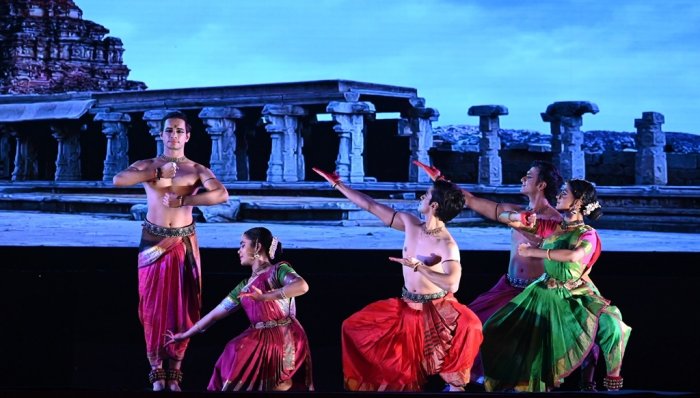 Parshwanath Upadhye & group Parshwanath Upadhye with his dancers of Punya Dance Company in Bangalore chose the theme of Roopa Aroopa (Form and formlessness), presented through the Bharatanatyam medium. Starting with a form based theme expressed in the sahitya and interpreted in the dance, he went on to abstract music based on just solfa syllables and rhythmic syllables, given a form through the dance and finally chose a devarnama, wherein divinity paid homage to, has its form engraved in the heart and mind of the worshipper. The sound tape began with raga Varali (as a full-fledged classical singer, Parshwanath has a keen musical sense) serenading the majestic Nagaraja, Giriraja, Himalayas bounding India in the north and protecting her - compared with the Jarjara of Lord Indira, formally planted on the stage before a performance as protection. The music serenades the Shikare Jaya Jaya , and the dance by the group suggests the enormity and massive grandeur of the mountains in the danced version. The prayer is linked to a Sabdam which is simple interpretative dance expression wherein the abstract music passages too are given a form in dance. So one experiences form in abstraction and also representing a definite idea. The group combined well and every dancer had excellent technique. The finale was a very stirring solo, based on a Kanakadasa composition in Kannada in Ragamalika, "Baro Krishnaiyya bhaktara manege eega", wherein the devotee ardently invites Krishna, pleading that he visit the home of his bhakta, immediately. Essentially it is Krishna in one's consciousness that the caller addresses, and what the dance shows is not so much the God himself, as much as the devotee's response to him.  Carolina Prada and Mayurbhanj Chhau Coming to the field of martial art as just art, Kalarigram, the Kalaripayattu gurukul, was set up in 2003 by Lakshman Gurukkal and his siblings Shatrughnan and Radha Gurukkal, at Auroville, Puducherry. Veeran, a Kalaripayattu and Mayurbhanj Chhau blend presented by Carolina Prada and group from Kalarigram, turned out to be a mind blower in its depiction of what is a traditional Theyyam story. The visuals of ice clad mountains, waters, and luxuriant greenery created a backdrop against which the story unfolded. It is a love story of a valiant fighter and the girl he falls in love with going awry, due to a sad misunderstanding. Carolina Prada's seductive cross legged walking with fluent Kalari high kicks and the young man wielding sword and shield in a Mayurbhanj Chhau movement expression, with one leg grounded and the other swirling in the air in broad, graceful sweeps, made an attractive pair, showing love blossoming with the two meeting against the blue waters and green fields. The tryst planned for a later, appointed time, however fails to materialise, with the young soldier sacrificing his life, having to answer the call of his profession - namely fighting enemies in a battle to protect his land. Ignorant of the developments and nursing feelings of being let down and crossed in love, the girl finally comes across her beloved's felled body in the battlefield and grieves. The audience is left with her body's agonised cartwheeling, renting the air with wails. The inspiring music was a feature of the production, the female singer Subhasree Parthasarathy, one of her kind. The vocalisations, the aural power of a persuasive takita, dikuta, akita to the belligerence of a takatakita apart, the pitch and voice range in the singing made one wonder as to the spaces in the body the vocal cords were placed in, from where sound emerged. A male singer Prabhat Bhaskaran sang the male parts. But nothing could compare with what the female voice provided! 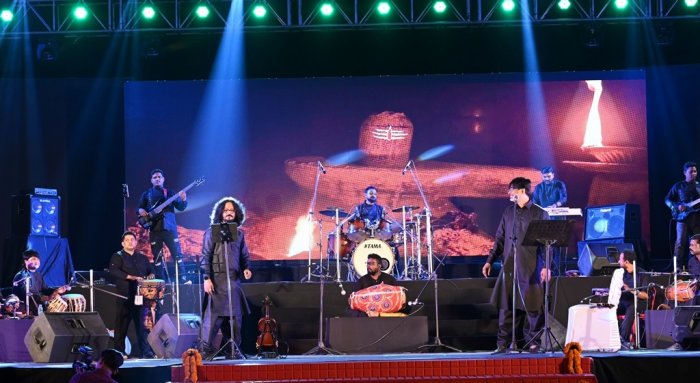 Vadya Vani & Shivagni Having an AIR Vadya Vrinda type of orchestral fare, has very judiciously become part of this festival. It provides the much needed opportunity for finished instrumentalists of all denominations, who are being regularly turned out, after years of classical training by institutions like Odissi Sangeet Mahavidyalaya, to compose and present creative instrumental ensembles. Mardal percussionist Dhaneswar Swain, violinist Agnimitra Behera, flautist Srinibas Satpathy and group, Vadya Vani Gurukul and Shivagni of Bhubaneswar in the Magical Mystic - Rhythm of Life, presented a large variety of percussion instruments in an ensemble. The vivacity of rhythm in an assortment of sounds and vocalisations like "tin nana kita", konakkol like recitations and what have you, was followed by the melodic ensembles with Ganesha, Music from and for the Soul, Fusion, Shivansh wherein one heard like the tread of marching, Ravana Stotra on Shiva. The finale with Srinibas Satpathy and Agnimitra Behera in a fusion accelerando took one's breath away with its superior virtuosity. One could not avoid the thought though, that the complete quietude of an 'Om Shivaya Namah' could have marked the end of the concert - instead of again taking off with fusion at such high speed - being more in tune with the idea of music evoking that bliss of complete peace within. 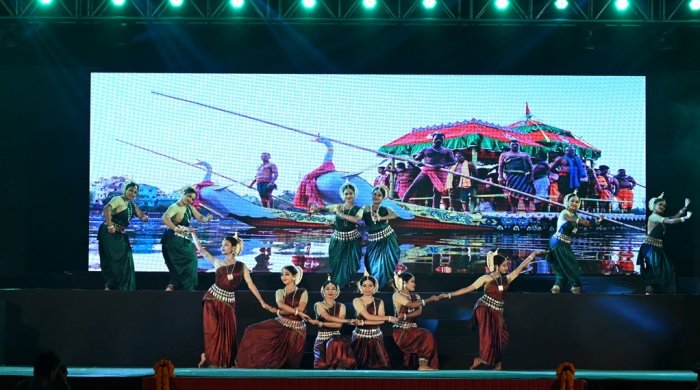 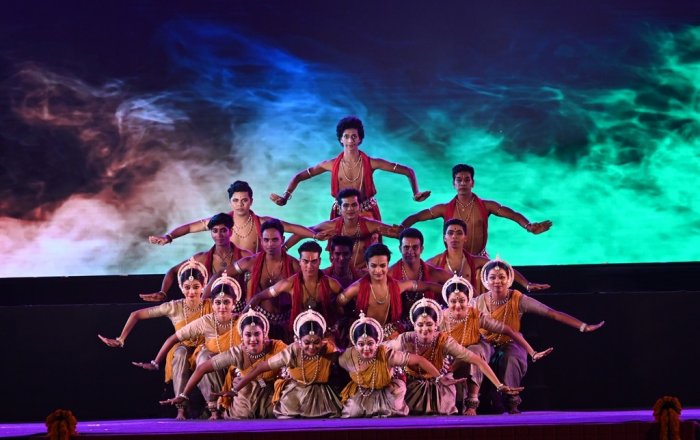 Ananya Odisha by Orissa Dance Academy Odissi dance representations, interpreting all aspects of the State, being encouraged as events welcoming guests during national events like Hockey India, has persuaded choreographers to think in imaginative ways, of how to use Odissi technique for hitherto unexplored themes. For one such State occasion, Orissa Dance Academy, with its sister dance organisations started by students of the Academy, Nrutya Naivedya and Odissi Dance Creation, in a joint effort, produced Ananya Odisha. Based on festivals of Odisha, poet/journalist Kedar Mishra's concept with music score by Sukant Kundu and Ramhari Das provided the foundational base, with dance choreography by senior guru and administrator, Aruna Mohanty. An enormous group of dancers covering all levels of the large stage, in amazing group discipline, projected fast moving, mind boggling scenes, in exemplary fashion - starting with obeisance to the tricolour as Sarvesham Janani Bharat was sung. Colourful visuals portraying the beauty of Odisha, Chandan Jatra images with the Chapa (boat) carrying the temple deities, to the Pakori, Rath Jatra, girls playing Baisaki, etc apart, dancing to songs which are an integral part of the culture of the region, evokes a kind of nostalgia - Jhulibe to aajo so commonly sung in Jhoolan Jatra, and Ganeshanko khela. Boys at the topmost level forming groups reciting "Vakratunda Mahakaya," folk steps while fragrant grain is offered to Goddess Lakshmi by girls draped in Sambalpuri sarees, hunting tribesmen, sailors crossing seas in conquest, Odissi as reflected so prominently on temple friezes and panels, Holi festival, and a final Utkal Janani Odisha's anthem - the scenes are too many to capture in detail - but the group understanding among such a large number of performers, was what astonished. Also conceived as a group offer during Hockey India, and dedicated to the patron deity of Odisha was Jagannath Ashtakam presented by Orissa Dance Academy (set up by late Guru Gangadhar Pradhan and now run by his student Aruna Mohanty), Nrutya Naivedya and Odissi Dance Creation, along with Soor Mandir and Rudrakshya Foundation. The music by Agnimitra Behera with rhythmic arrangements by Dhaneswar Swain, with singers Roopak Parida and Nazia Alam, had its danced interpretation in Aruna Mohanty's choreography. As cries raised to Chaturbhuja Jagannath, of Govinda Vithala and Sri Krishna Govind Hare Harare filled the air, the group formations on stage were made not just by dancing bodies, but also by the Tahia carried by each dancer (arch shaped with lattice work, the Tahia provides the backdrop for Jagannath and the other idols, during the Ratha Jatra). Held in different positions, the dancers created patterns on the stage, along with the dancing poses. The performers moved in unison - now a common feature with so many dancers coming together in massive productions. 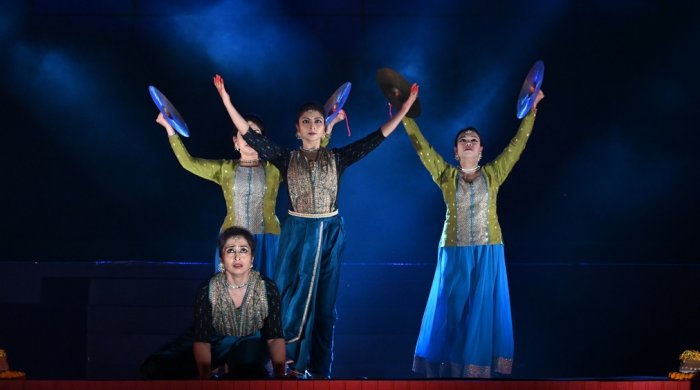 Samskritiki Shreyaskar The Kathak contribution for the festival came from Samskritiki Shreyaskar, Kolkata, set up by late dancer Rani Karnaa. The programme titled Sanjog, comprised lead dancers Debashree Bhattacharya and Sohini Debnath, both senior students of Rani Karnaa, and a small group. While commendably trained, two dancers, seated for a long time on a side of such a vast stage, got lost to the audience, and the dark costume they wore, under mood lights, did not help to make the figures stand out. Also the choice of a highly internalised item, wherein music brings about that state of utter peace and tranquillity, so completely based on the evoked state of being, with very little movement action, meant that for an audience seated so far back from an enormous stage, nothing was visible in terms of stage moves. The music was of high quality. Chatushpadi Chakradharana in Darbari composed for their Guru, with music envisaged by S.K. Saxena, the scholar/ author himself, was one of Rani Karnaa's finest items. Music like the Carnatic counterpart, with sruti bhed, several ragas peeped in like Durga, Bhopali, Kedar. Only in the Tarana in raga Darbari, could one get some group action. What works in the interiors of an auditorium, within closed space, will not succeed on a big performance arena, open to the elements. The choice of items needs to be governed by the type of performance space one is rehearsing for.  Project Chhauni group The last dance presentation Gaia-Mother Earth, was an enigma. It was printed and announced as a blend of Odissi and Mayurbhanj Chhau, by Project Chhauni Baripada, prepared by Subhasree Mukherjee, a Chhau dancer, the project being an initiative of the District Administration of Mayurbhanj to revive "the lost glory of Chhau." The choreography was by Chhau/Odissi dancer Ileana Citaristi. But it turned out to be largely Odissi, presented by Ileana Citaristi's Art Vision, with her playing the role of Bhoomi Devi. The theme based on a folk tale, meant to inspire respect for Earth, exhorted man not to destroy the natural environment. The Chhau part, towards the fag end, apart from being too miniscule to register, did not have very strong dancers. Guru Gangadhar Smruti Samman 2023 was presented to eminent vocalist Guru Bankim Sethi, dance Guru Niranjan Rout, mardala exponent Guru Satchidananda Das and Mayurbhanj Chhau exponent Guru Sadasiba Pradhan. The prestigious Buddha Samman went to renowned Odissi classical vocalist and music composer Shyamamani Devi.  Writing on the dance scene for the last forty years, Leela Venkataraman's incisive comments on performances of all dance forms, participation in dance discussions both in India and abroad, and as a regular contributor to Hindu Friday Review, journals like Sruti and Nartanam, makes her voice respected for its balanced critiquing. She is the author of several books like Indian Classical dance: Tradition in Transition, Classical Dance in India and Indian Classical dance: The Renaissance and Beyond. Post your comments Pl provide your name and email id along with your comment. All appropriate comments posted with name and email id in the blog will also be featured in the site. |